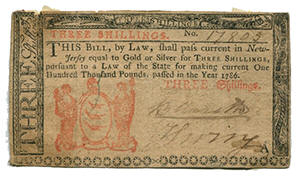| |
| |
|
|
|
| |
| |
"BY 700 & 1 LBS. OF BARREL STAVES" ---
THE COOPER
John DeLong, the area's resident shoemaker/cobbler
must have had a talent for multi-tasking (as it
appears that he was also the region's cooper, the
barrel-maker). We note that he paid off part of the
charges accrued at Dupui's general store by way of
cash, sheep, pipe staves (½ hundred), and barrel
staves (701 lbs.).
Barrels, of course, were used for such commodities
as tare, midlins, and flour, as well as serving as
containers for rum and whiskey (among their many
other uses).
While intrigued as to why anyone would accept barrel
staves as a form of payment, there are other ledger
entries in the cooper's account that are equally
mysterious. For example, one notes two separate
entries for payment to Dupui: "By Cash at Trenton,"
(the first in March of 1786; the second in May
1787). Can we even begin to hazard a guess as to
what cooper Delong's and Dupui's mutual interest
might have been at Trenton, NJ?
We do know that at that time Trenton was home to the
Trenton Iron works, and Delong may have been in need
of metal bands for his barrels. We also know that a
major stoneware pottery factory in Trenton had been
established by James Rhodes, and it's certainly
possible that tavernkeeper Dupui was in need of
ceramic mugs for his tavern. At the very least, the
entries indicate that Trenton was an area of mutual
interest.
So what else was going on in the Trenton
area at the time?
In short, new currency had just been
introduced, the Trenton
3-shilling note.
This is what our post-Revolution paper money
actually looked like.
If you were a businessman or tavern operator
of the period, it would certainly behoove
you to know what the newest real paper
currency looked like (as counterfeit bills
had long plagued the region, with
counterfeit notes having been circulated as
early as the 1730s). |
|
 |
 |
|
|
| |
|
|
|
|
|
| |
|
|
|
| |
|
|
|
| |
|
|
| |
|
|
|
|